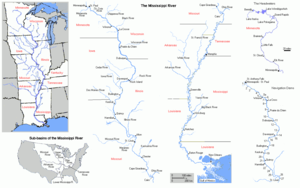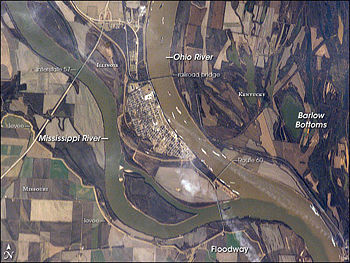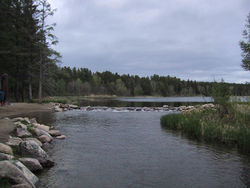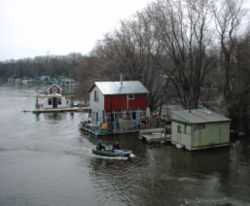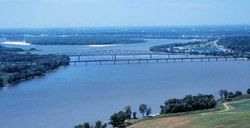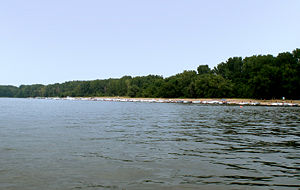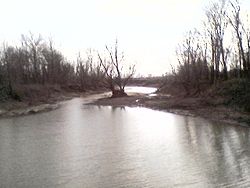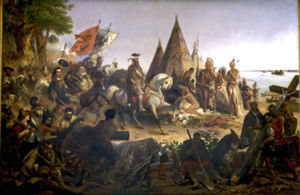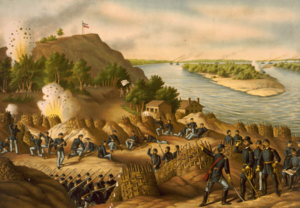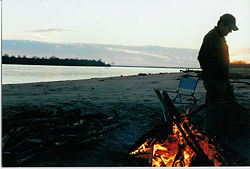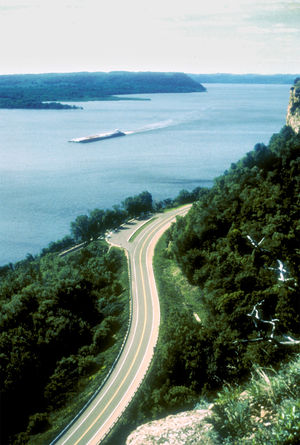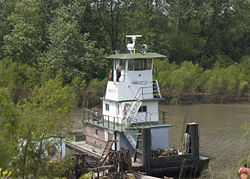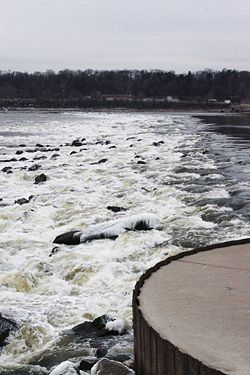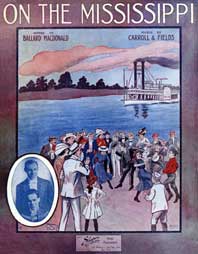Mississippi River
2008/9 Schools Wikipedia Selection. Related subjects: North American Geography
| Mississippi River | |
| River | |
|
Mississippi River in New Orleans, Louisiana (2006)
|
|
| Country | |
|---|---|
| States | |
| Tributaries | |
| - left | Ohio River |
| - right | Missouri River, Arkansas River |
| Cities | Minneapolis and St. Paul, MN, St. Louis, MO, Memphis, TN, Baton Rouge, LA, New Orleans, LA |
| Source | Lake Itasca |
| - location | Itasca State Park, Clearwater County, MN |
| - elevation | 1,475 ft (450 m) |
| - coordinates | |
| Mouth | Gulf Of Mexico |
| - location | Pilottown, Plaquemines Parish, LA |
| - elevation | 0 ft (0 m) |
| - coordinates | |
| Length | 2,340 mi (3,766 km) |
| Basin | 1,151,000 sq mi (2,981,076 km²) |
| Discharge | for Baton Rouge, LA |
| - average | 450,000 cu ft/ s (12,743 m³/ s) |
The Mississippi River is the second longest river in the United States, with a length of 2,340 miles (3,770 km) from its source in Lake Itasca in Minnesota to its mouth in the Gulf of Mexico. The longest river, a Mississippi tributary, is the Missouri River measuring 2,540 miles (4,090 km).
The Mississippi River is part of the Jefferson-Missouri-Mississippi river system, which is the largest river system in North America and among the largest in the world: by length (3,900 miles (6,300 km)), it is the fourth longest, and by its average discharge of 572,000 cu ft/s (16,200 m³/s), it is the tenth largest river.
The name Mississippi is derived from the Ojibwe word misi-ziibi ("Great River") or gichi-ziibi ("Big River") at its headwaters.
Geography
The Missouri River flows from the confluence of the Jefferson, Madison, and Gallatin to the Mississippi River. Taken together, the Jefferson, the Missouri, and the Mississippi form the longest river system in North America. If measured from the source of the Jefferson at Brower's Spring, to the Gulf of Mexico, the length of the Mississippi-Missouri-Jefferson combination is approximately 3,900 miles (6,300 km), making the combination the 4th longest river in the world. The uppermost 207 miles (333 km) of this combined river are called the Jefferson, the lowest 1,352 miles (2,176 km) are part of the Mississippi, and the intervening 2,341 miles (3,767 km) are called the Missouri.
The Arkansas River is the second longest tributary of the Mississippi River. Measured by water volume, the largest of all Mississippi tributaries is the Ohio River.
The widest point of the Mississippi River is Lake Onalaska, near La Crosse, Wisconsin, where the river is over 4 miles (6.4 km) wide. Since Lake Onalaska was created by Lock and Dam No. 7, Lake Pepin is historically the widest natural spot at more than two miles (3 km) wide. However, these areas are reservoirs rather than free flowing water. In areas where the Mississippi is a flowing river, it exceeds one mile (1.6 km) in width in several places in its lower course.
The Mississippi River runs through 10 states and was used to define portions of these states' borders. The middle of the riverbed at the time the borders were established was the line to define the borders between states. The river has since shifted, but the state borders of Wisconsin, Iowa, Illinois, Missouri, Kentucky, Arkansas, Tennessee, and Mississippi have not changed; they still follow the former bed of the Mississippi River as of their establishment.
The river is divided into the upper Mississippi, from its source south to the Ohio River, and the lower Mississippi, from the Ohio to its mouth near New Orleans, Louisiana.
Upper Mississippi River
The upper Mississippi is divided into three sections: the headwaters, from the source to Saint Anthony Falls; a series of man-made lakes between Minneapolis and St. Louis, Missouri; and the middle Mississippi, a relatively free-flowing river downstream of the confluence with the Missouri River at St. Louis.
Tributaries
The Mississippi is joined by the Minnesota River south of the Twin Cities, the Wisconsin River in Prairie du Chien, Wisconsin, the St. Croix River near Prescott, Wisconsin, the Iowa River near Wapello, Iowa, the Skunk River south of Burlington, Iowa, the Des Moines River in Keokuk, Iowa, the Illinois River and the Missouri River near St. Louis, and by the Ohio River at Cairo, Illinois.
Lower Mississippi River
Major sub-tributaries include the Tennessee River (a tributary of the Ohio River) and the Platte River (a tributary of the Missouri River). The Arkansas River joins the Mississippi in southeastern Arkansas. The Atchafalaya River in Louisiana is a major distributary of the Mississippi.
Cities along the river
The cities below have either historic significance or cultural lore connecting them to the Mississippi River. They are ordered from the beginning of the river to its end.
- Bemidji, Minnesota
- Little Falls, Minnesota
- Saint Cloud, Minnesota
- Minneapolis, Minnesota
- St. Paul, Minnesota
- Winona, Minnesota
- La Crosse, Wisconsin
- Dubuque, Iowa
- Bettendorf, Iowa
- Davenport, Iowa
- Rock Island, Illinois
- Moline, Illinois
- Muscatine, Iowa
- Burlington, Iowa
- Fort Madison, Iowa
- Nauvoo, Illinois
- Keokuk, Iowa
- Quincy, Illinois
- Hannibal, Missouri
- St. Louis, Missouri
- Ste. Genevieve, Missouri
- Cape Girardeau, Missouri
- caruthersville, Missouri
- Cairo, Illinois
- New Madrid, Missouri
- Columbus, Kentucky
- Hickman, Kentucky
- Reverie, Tennessee
- Memphis, Tennessee
- Tunica, Mississippi
- Helena-West Helena, Arkansas
- Greenville, Mississippi
- Vicksburg, Mississippi
- Natchez, Mississippi
- Baton Rouge, Louisiana
- New Orleans, Louisiana
- Pilottown, Louisiana
- La Balize, Louisiana (historical)
Bridge crossings
The first bridge across the Mississippi River was built in 1855. It spanned the river in Minneapolis where the current Hennepin Avenue Bridge is located.
The first railroad bridge across the Mississippi was built in 1856. It spanned the river between Arsenal Island at Rock Island, Illinois, and Davenport, Iowa. Steamboat captains of the day, fearful of competition from the railroads, considered the new bridge "a hazard to navigation". Two weeks after the bridge opened, the steamboat Effie Afton rammed part of the bridge and started it on fire. Legal proceedings ensued, with Abraham Lincoln defending the railroad. The lawsuit went to the Supreme Court of the United States and was eventually ruled in favour of Lincoln and the railroad.
Below is a general overview of bridges over the Mississippi which have notable engineering or landmark significance with its city. They are ordered from the source to the mouth.
- Stone Arch Bridge - a former Great Northern Railroad (now pedestrian) bridge in Minneapolis.
- Interstate 35W Mississippi River Bridge - This bridge collapsed catastrophically on August 1, 2007, killing 13 and injuring over 100. It is scheduled to be replaced by the St. Anthony Bridge, to open in September 2008.
- Black Hawk Bridge, connecting Lansing, Allamakee County, Iowa to rural Crawford County, Wisconsin, locally referred to as the Lansing Bridge and documented in the Historic American Engineering Record.
- Julien Dubuque Bridge - A bridge connecting Dubuque, Iowa and East Dubuque, Illinois, that is listed in the National Register of Historic Places.
- Interstate 74 Bridge connecting Moline, Illinois, to Bettendorf, Iowa, is a twin suspension bridge, also known historically as the Iowa-Illinois Memorial Bridge.
- Rock Island Government Bridge connecting Rock Island, Illinois, to Davenport, Iowa. Located just southwest of the site of the first bridge across the Mississippi River, it is one of only two bridges in the world with two sets of railroad tracks above the auto lanes. It is co-located with Lock and Dam #15, the largest roller dam in the world.
- Rock Island Centennial Bridge connecting Rock Island, Illinois, to Davenport, Iowa.
- Norbert F. Beckey Bridge connecting Muscatine, Iowa, to Rock Island County, Illinois, became the country's first bridge to be illuminated with light-emitting diode lights decoratively illuminate the facade of the bridge.
- Great River Bridge - cable-stayed bridge, connecting Burlington, Iowa, to Gulf Port, Illinois.
- Santa Fe Bridge - in Fort Madison, Iowa, the largest double-deck swing-span bridge in the world. It is the last operating swing bridge over the Mississippi River for automobile traffic and is listed in the National Register of Historic Places.
- Quincy Bayview Bridge - cable-stayed bridge connecting Quincy, Illinois, and West Quincy, Missouri, via westbound US Highway 24. Eastbound traffic into Quincy is served by the older Quincy Memorial Bridge.
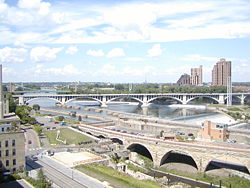
- Clark Bridge also known as the Super Bridge as the result of an appearance on PBS program Nova. This cable-stay bridge constructed in 1994 connects Alton, Illinois, to Black Jack, Missouri. It is the northernmost river crossing in the St. Louis metropolitan area and is named after explorer William Clark.
- Chain of Rocks Bridge - A bridge on the northern edge of St. Louis; famous for a 22-degree bend halfway across and the most famous alignment of Historic Route 66 across the Mississippi.
- Eads Bridge - A bridge connecting St. Louis and East St. Louis, Illinois; the first major steel bridge in the world, and also a National Historic Landmark. This bridge now carries the St. Louis MetroLink light rail system.
- Chester Bridge - The bridge that connects Chester, Illinois, to Missouri and eventually Perryville, Missouri. The bridge has been struck at least twice by tornadoes.
- Hernando de Soto Bridge - carries Interstate 40 to connect Memphis, Tennessee and West Memphis, Arkansas; listed in Guinness Book of World Records for its unique structural "letter" shape.
- Frisco Bridge - was the first crossing of the Lower Mississippi and the longest cantilever truss steel railroad bridge in North America when it opened on May 12, 1892. It connects Memphis and West Memphis and is listed as a Historic Civil Engineering Landmark.
- Memphis & Arkansas Bridge - the longest Warren truss- style bridge in the United States which carries Interstate 55 to connect Memphis and West Memphis; also listed on the National Register of Historic Places.
- Huey P. Long Bridge - Jefferson Parish, Louisiana, the first Mississippi River span built in Louisiana.
- Crescent City Connection - connects the east and west banks of New Orleans, Louisiana; the 5th-longest cantilever bridge in the world.
Nomenclature
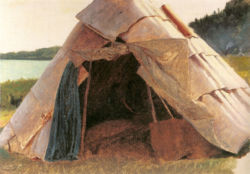
The word Mississippi comes from Messipi, the French rendering of the Anishinaabe (Ojibwe or Algonquin) name for the river, Misi-ziibi ("Great River").
The Ojibwa called Lake Itasca Omashkoozo-zaaga'igan ("Elk Lake") and the river flowing out of it Omashkoozo-ziibi ("Elk River"). After flowing into Lake Bemidji, the Ojibwe called the river Bemijigamaa-ziibi ("River from the Traversing Lake"). After flowing into Cass Lake, the name of the river again changed to Miskwaawaakokaa-ziibi ("Red Cedar River") and then to Gichi-ziibi ("Great River") after flowing into Lake Winnibigoshish. The Ojibwe name Misi-ziibi applied only to the portion below the Crow Wing River, but the ever-changing names of the river seemed illogical to the English speakers.
After the expeditions by Giacomo Costantino Beltrami and Henry Schoolcraft, the longest stream above the juncture of the Crow Wing River and Gichi-ziibi was named Mississippi River.
In Cheyenne the Mississippi River is called Máˀxe-éˀometaaˀe ("Big Greasy River").
Because of its size and historical significance, the Mississippi has many nicknames. Among these are:
- The Father of Waters
- The Gathering of Waters
- The Big Muddy (more commonly associated with the Missouri River)
- Big River
- Ol' Man River (a nickname immortalized by Oscar Hammerstein II and Jerome Kern in their song from the classic musical Show Boat)
- The Great River
- Body of a Nation
- The Mighty Mississippi
- El Grande (by Hernando de Soto)
- The Muddy Mississippi
- Old Blue
- Moon River
- Ol' Miss
Watershed
The Mississippi River has the third largest drainage basin (or catchment) in the world, exceeded in size only by the watersheds of the Amazon River and Congo River. It drains 41% of the 48 Continental United States. The basin covers more than 1,245,000 sq mi (3,225,000 km²), including all or parts of 31 states and two Canadian provinces. The drainage basin empties into the Gulf of Mexico.
Major tributaries of the Mississippi:
- Big Black River in Mississippi
- Yazoo River in Mississippi
- Red River in Louisiana
- White River in Arkansas
- Arkansas River in Arkansas
- Ohio River in Kentucky
- Big Muddy River in Illinois
- Kaskaskia River in Illinois
- Missouri River in Missouri
- Illinois River in Illinois
- Des Moines River in Iowa
- Skunk River in Iowa
- Rock River in Illinois
- Maquoketa River in Iowa
- Wisconsin River in Wisconsin
- Chippewa River in Wisconsin
- St. Croix River (Wisconsin-Minnesota) in Minnesota And Wisconsin
- Minnesota River in Minnesota
- Crow River in Minnesota
Drainage area
The Mississippi River drains most of the area between the Rocky Mountains and the Appalachian Mountains, except for the areas drained to the Hudson Bay via the Red River of the North, by the St. Lawrence River and the Great Lakes, the Rio Grande (and numerous other rivers in Texas), the Alabama River- Tombigbee River, and the Chattahoochee River- Appalachicola River.
The Mississippi River empties into the Gulf of Mexico about 100 miles (160 km) downstream from New Orleans. Measurements of the length of the Mississippi from Lake Itasca to the Gulf of Mexico vary somewhat, but the United States Geological Survey's number is 2,340 miles (3,770 km). The retention time from Lake Itasca to the Gulf is about 90 days.
Outflow
Fresh river water flowing from the Mississippi into the Gulf of Mexico does not mix into the salt water immediately. The images from NASA's MODIS to the right show a large plume of fresh water, which appears as a dark ribbon against the lighter-blue surrounding waters.
The images demonstrate that the plume did not mix with the surrounding sea water immediately. Instead, it stayed intact as it flowed through the Gulf of Mexico, into the Straits of Florida, and entered the Gulf Stream. The Mississippi River water rounded the tip of Florida and traveled up the southeast coast to the latitude of Georgia before finally mixing in so thoroughly with the ocean that it could no longer be detected by MODIS.
Discharge
The Mississippi river discharges at an annual average rate of between 200,000 and 700,000 cu ft/s (7,000 to 20,000 m³/s). Although it is the 5th largest river in the world by volume, this flow is a mere fraction of the output of the Amazon, which moves nearly 7 million cu ft/s (200,000 m³/s) during wet seasons. On average the Mississippi has only 9% the flow of the Amazon River but is nearly twice that of the Columbia River and almost 6 times the volume of the Colorado River.
History
Course changes
The Illinoian Glacier, about 200,000 to 125,000 years before present, blocked the Mississippi near Rock Island, Illinois, diverting it to its present channel farther to the west, the current western border of Illinois.
The Hennepin Canal roughly follows the ancient channel of the Mississippi downstream from Rock Island to Hennepin. South of Hennepin, Illinois, the current Illinois River is actually following the ancient channel of the Mississippi River to Alton, Illinois, before the Illinoian glaciation.
Other changes in the course of the river have occurred because of earthquakes along the New Madrid Fault Zone, which lies between Memphis and St. Louis. Three earthquakes in 1811 and 1812, estimated at approximately 8 on the Richter Scale, were said to have temporarily reversed the course of the Mississippi. The settlement of Reverie, Tennessee was cut off from Tipton County, Tennessee, during the 1811 and 1812 earthquakes and placed on the western side of the Mississippi River, the Arkansas side. These earthquakes also created Reelfoot Lake in Tennessee from the altered landscape near the river. The faulting is related to an aulacogen (geologic term for a failed rift) that formed at the same time as the Gulf of Mexico.
Through a natural process known as delta switching the lower Mississippi River has shifted its final course to the mouth of the Gulf of Mexico every thousand years or so. This occurs because the deposits of silt and sediment begin to clog its channel, raising the river's level and causing it to eventually find a steeper, more direct route to the Gulf of Mexico. The abandoned distributary diminishes in volume and forms what are known as bayous. This process has, over the past 5,000 years, caused the coastline of south Louisiana to advance toward the Gulf from 15 to 50 mi (25 to 80 km). The currently active delta lobe is called the Birdfoot Delta, after its shape, or the Balize Delta, after La Balize, Louisiana, the first French settlement at the mouth of the Mississippi.
Native Americans
The area of the Mississippi valley was first settled by Native American tribes such as the Ojibwa, the Cheyenne, the Mississippian Culture and the Chickasaw.
European exploration
On May 8, 1541, Spanish explorer Hernando de Soto became the first recorded European to reach the Mississippi River, which he called Rio de Espiritu Santo ("River of the Holy Spirit"), in the area of what is now Mississippi. In Spanish the river is called Rio Misisipi.
French explorers Louis Joliet and Jacques Marquette began exploring the Mississippiin the 17th century. Marquette traveled with a Sioux named Ne Tongo ("Big river" in Sioux language) in 1673. Marquette proposed calling it the River of the Immaculate Conception.
In 1682, René Robert Cavelier, Sieur de La Salle and Henri de Tonty claimed the entire Mississippi River Valley for France, calling the river Colbert River after Jean-Baptiste Colbert and the region La Louisiane, for King Louis XIV. On March 2, 1699, Pierre Le Moyne d'Iberville rediscovered the mouth of the Mississippi, following the death of La Salle. The French built the small fort of La Balise there to control passage.
In 1718, about 100 miles (160 km) upriver, New Orleans was established along the river crescent by Jean-Baptiste Le Moyne de Bienville, with construction patterned after the 1711 resettlement on Mobile Bay of Mobile, the capital of French Louisiana at the time.
18th century
The Treaty of Paris (1763) gave the Kingdom of Great Britain rights to all land in the valley east of the Mississippi and Spain rights to land west of the Mississippi. Spain also ceded Florida to England to regain Cuba, which the English occupied during the war. Britain then divided the territory into East Florida and West Florida.
Article 8 of the Treaty of Paris (1783) states, "The navigation of the river Mississippi, from its source to the ocean, shall forever remain free and open to the subjects of Great Britain and the citizens of the United States." With this treaty, which ended the American Revolution, Britain also ceded West Florida back to Spain to regain the Bahamas, which Spain had occupied during the war. Spain then had control over the river south of 32°30' north latitude and, in what is known as the Spanish Conspiracy, hoped to gain greater control of Louisiana and all of the west. These hopes ended when Spain was pressured into signing Pinckney's Treaty in 1795.
19th century
France reacquired 'Louisiana' from Spain in the secret Treaty of San Ildefonso in 1800. The United States bought the territory from France in the Louisiana Purchase of 1803. In 1815, the US defeated Britain at the Battle of New Orleans, part of the War of 1812, securing American control of the river.
Steamboat commerce
Mark Twain's book Life on the Mississippi covered the steamboat commerce which took place from 1830 to 1870 on the river before more modern ships replaced the steamer. The book was published first in serial form in Harper's Weekly in seven parts in 1875. The full version, including a passage from the unfinished Huckleberry Finn and works from other authors, was published by James R. Osgood & Company in 1885.
The first steamboat to travel the full length of the Mississippi from the Ohio River to New Orleans was the New Orleans in December 1811. Its maiden voyage occurred during the series of New Madrid earthquakes in 1811–12.
Steamboat transport remained a viable industry (both in terms of passengers and freight) until the end of the first decade of the 20th century. Among the several Mississippi River system steamboat companies was the noted Anchor Line, which from 1859 to 1898 operated a luxurious fleet of steamers between St. Louis and New Orleans.
Civil War
The river played a decisive role in the American Civil War. The Union's Vicksburg Campaign called for Union control of the lower Mississippi River. The Union victory at the Battle of Vicksburg in Warren County, Mississippi in 1863 was pivotal to the Union's final victory of the Civil War.
20th century
In the spring of 1927, the river broke out of its banks in 145 places during the Great Mississippi Flood of 1927 and inundated 27,000 sq mi (70,000 km²) to a depth of up to 30 ft (10 m).
On October 20, 1976, the automobile ferry MV George Prince was struck by a ship traveling upstream as the ferry attempted to cross from Destrehan, Louisiana, to Luling, Louisiana. Seventy-eight passengers and crew died, only eighteen survived the accident.
In 1988, record low water levels provided an opportunity and obligation to examine the climax of the wooden-hulled age. The Mississippi fell to 10 feet (3.0 m) below zero on the Memphis gauge. Four and a half acres of water craft remains were exposed on the bottom of the Mississippi River at West Memphis, Arkansas. They dated to the late 19th to early 20th centuries. The State of Arkansas, the Arkansas Archeological Survey, and the Arkansas Archeological Society responded with a two-month data recovery effort. The fieldwork received national media attention as good news in the middle of a drought.
The Great Flood of 1993 was another significant flood, primarily affecting the Mississippi above its confluence with the Ohio River at Cairo, Illinois.
Two portions of the Mississippi were designated as American Heritage Rivers in 1997: the lower portion around Louisiana and Tennessee, and the upper portion around Iowa, Illinois, Minnesota and Missouri.
21st century
In 2002, Slovenian long-distance swimmer Martin Strel swam the entire length of the river, from Minnesota to Louisiana, over the course of 68 days.
In 2005, the Source to Sea Expedition ( http://sourcetosea.net) paddled the Mississippi and Atchafalaya rivers to benefit the Audubon Society's Upper Mississippi River Campaign.
On August 1, 2007, the I-35W Mississippi River bridge in Minneapolis collapsed during the evening rush hour.
Also in 2007, it is expected that more than 150 pleasure boats will travel down the river from Grafton to Cairo while participating in the Great loop, which is circumnavigation of Eastern North America by water.
Recreation
Water Skiing
The sport of water skiing was invented on the river in a wide region between Minnesota and Wisconsin known as Lake Pepin. Ralph Samuelson of Lake City, Minnesota, created and refined his skiing technique in late June and early July 1922. He later performed the first water ski jump in 1925 and was pulled along at 80 miles per hour (128 km/h) by a Curtiss flying boat later that year.
National Parks
There are seven National Park Service sites along the Mississippi River. The Mississippi National River and Recreation Area is the National Park Service site dedicated to protecting and interpreting the Mississippi River itself. The other six National Park Service sites along the river are (listed from north to south): Effigy Mounds National Monument, Jefferson National Expansion Memorial (AKA The Arch), Vicksburg National Military Park, Natchez National Historical Park, New Orleans Jazz National Historical Park, and Jean Lafitte National Historical Park and Preserve.
Navigation history
A clear channel is needed for the barges and other vessels that make the mainstem Mississippi one of the great commercial waterways of the world. The task of maintaining a navigation channel is the responsibility of the U.S. Army Corps Of Engineers, which was established in 1802. Earlier projects began as early as 1829 to remove snags, close off secondary channels and excavate rocks and sandbars.
Steamboats entered trade in the 1820s, so by the period of the 1830-1850 became the golden age of steamboats. As there were few roads or rails in the lands of the Louisiana Purchase river traffic was an ideal solution. Cotton, timber and food came down the river, as did Appalachia coal. The port of New Orleans boomed as it was the trans-shipment point to deep sea ocean vessels. As a result, the image of the twin stacked, wedding cake Mississippi steamer entered into American mythology. Steamers worked the entire route from the trickles of Montana, to the Ohio river; down the Missouri and Tennessee. To the main channel of the Mississippi. Only the arrival of the railroads in the 1880s did steamboat traffic diminish. Steamboats remained a feature until the 1920s. Most have been superseded by pusher tugs. A few survive as icons--the Delta Queen and the River Queen for instance.
A series of 29 locks and dams on the upper Mississippi, most of which were built in the 1930s, is designed primarily to maintain a 9 ft (2.7 m) deep channel for commercial barge traffic. The lakes formed are also used for recreational boating and fishing. The dams make the river deeper and wider but do not stop it. No flood control is intended. During periods of high flow, the gates, some of which are submersible, are completely opened and the dams simply cease to function. Below St. Louis, the Mississippi is relatively free-flowing, although it is constrained by numerous levees and directed by numerous wing dams.
19th century
Obstacles - Des Moines, Iowa/Illinois
In 1829, there were surveys of the two major obstacles on the upper Mississippi, the Des Moines Rapids and the Rock Island Rapids, where the river was shallow and the riverbed was rock. The Des Moines Rapids were about 11 mi (18 km) long and just above the mouth of the Des Moines River at Keokuk, Iowa. The Rock Island Rapids were between Rock Island and Moline, Illinois. Both rapids were considered virtually impassable.
In 1848, the Illinois and Michigan Canal was built to connect the Mississippi River to Lake Michigan via the Illinois River near Peru, Illinois. In 1900, the canal was replaced by the Chicago Sanitary and Ship Canal. The canal allowed Chicago to address specific health issues (typhoid, cholera and other waterborne diseases) by sending its waste down the Illinois and Mississippi river systems rather than polluting its water source of Lake Michigan. The canal also provided a shipping route between the Great Lakes and the Mississippi.
The Army Corps of Engineers recommended the excavation of a 5 ft (1.5 m) deep channel at the Des Moines Rapids, but work did not begin until after Lieutenant Robert E. Lee endorsed the project in 1837. The Corps later also began excavating the Rock Island Rapids. By 1866, it had become evident that excavation was impractical, and it was decided to build a canal around the Des Moines Rapids. The canal opened in 1877, but the Rock Island Rapids remained an obstacle.
In 1878, Congress authorized the Corps to establish a 4.5 ft (1.4 m) deep channel to be obtained by building wing dams which direct the river to a narrow channel causing it to cut a deeper channel, by closing secondary channels and by dredging. The channel project was complete when the Moline Lock, which bypassed the Rock Island Rapids, opened in 1907.
Canal - St. Paul, Minnesota
To improve navigation between St. Paul, Minnesota, and Prairie du Chien, Wisconsin, the Corps constructed several dams on lakes in the headwaters area, including Lake Winnibigoshish and Lake Pokegama. The dams, which were built beginning in the 1880s, stored spring run-off which was released during low water to help maintain channel depth.
In 1907, Congress authorized a 6 foot (1.8 m) deep channel project on the Mississippi, which was not complete when it was abandoned in the late 1920s in favour of the 9 foot (2.7 m) deep channel project.
20th century
Dam - Keokuk, Iowa
In 1913, construction was complete on a dam at Keokuk, Iowa, the first dam below St. Anthony Falls. Built by a private power company to generate electricity, the Keokuk dam was one of the largest hydro-electric plants in the world at the time. The dam also eliminated the Des Moines Rapids.
Lock and Dam No. 1 & 2
Lock and Dam No. 1 was completed in Minneapolis, Minnesota in 1917.
Lock and Dam No. 2 at Hastings, Minnesota, was completed in 1930.
1927 flood
Prior to the 1927 flood, the Corps' primary strategy was to close off as many side channels as possible to increase the flow in the main river. It was thought that the river's velocity would scour off bottom sediments, deepening the river and decreasing the possibility of flooding.
The 1927 flood proved this to be so wrong that communities threatened by the flood began to create their own levee breaks to relieve the force of the rising river.
Rivers and Harbors Act - 1930
The Rivers and Harbors Act of 1930 authorized the 9 ft (2.7 m) channel project, which called for a navigation channel 9 ft (2.7 m) deep and 400 ft (120 m) wide to accommodate multiple-barge tows.
This was achieved by a series of locks and dams, and by dredging. Twenty-three new locks and dams were built on the upper Mississippi in the 1930s in addition to the three already in existence.
Two new locks were built north of Lock and Dam No. 1 at Saint Anthony Falls in the 1960s, extending the head of navigation for commercial traffic by several miles, but few barges go past the metropolis of Minneapolis- Saint Paul, Minnesota today.
Late 20th century
Until the 1950s, there was no dam below Lock and Dam 26 at Alton, Illinois. Lock and Dam 27, which consists of a low-water dam and an 8.4 mi (13.5 km) long canal, was added in 1953 just below the confluence with the Missouri River, primarily to bypass a series of rock ledges at St. Louis. It also serves to protect the St. Louis city water intakes during times of low water.
U.S. government scientists determined in the 1950s that the Mississippi River was starting to switch to the Atchafalaya River channel because of its much steeper path to the Gulf of Mexico. Eventually the Atchafalaya River would capture the Mississippi River and become its main channel to the Gulf of Mexico, leaving New Orleans on a side channel. As a result, the U.S. Congress authorized a project called the Old River Control Structure, which has prevented the Mississippi River from leaving its current channel that drains into the Gulf via New Orleans.
Because the large scale of high-energy water flow threatened to damage the structure, an auxiliary flow control station was built adjacent to the standing control station. This US$300 million project was completed in 1986 by the U.S. Army Corps Of Engineers.
Beginning in the 1970s, the Corps applied hydrology transport models to analyze flood flow and water quality of the Mississippi.
Dam 26 at Alton, Illinois, which had structural problems, was replaced by the Mel Price Lock and Dam in 1990. The original Lock and Dam 26 was demolished.
21st century
Main floodways
The Corps now actively creates floodways to divert periodic water surges into backwater channels and lakes. The main floodways are the Birds Point-New Madrid Floodway, the Morganza Floodway, which directs floodwaters down the Atchafalaya River and the Bonnet Carré Spillway which directs water to Lake Pontchartrain.
The Old River Control structure also serve as a major floodgates that can be opened to prevent flooding. Some of the pre-1927 strategy is still in use today, the Corps actively cuts the necks of horseshoe bends, allowing the water to move faster and reducing flood heights.
Arts and culture
Literature
William Faulkner uses the Mississippi River and Delta as the setting for many hunts throughout his novels. It has been proposed that in Faulkner's famous story, The Bear, young Ike first begins his transformation into a man, thus relinquishing his birthright to land in Yoknapatawpha County through his realizations found within the woods surrounding the Mississippi River.
Many of the works of Mark Twain deal with or take place near the Mississippi River. One of his first major works, Life on the Mississippi, is in part a history of the river, in part a memoir of Twain's experiences on the river, and a collection of tales that either take place on or are associated with the river. The Mississippi River was noted for the number of bandits which called its islands and shores home, including John Murrell who was a well-known murderer, horse stealer and slave "re-trader". His notoriety was such that author Twain devoted an entire chapter to him in Life on the Mississippi, and Murrell was rumored to have an island headquarters on the river at Island 37. Twain's most famous work, Adventures of Huckleberry Finn, is largely a journey down the river. The novel works as an episodic meditation on American culture with the river having multiple different meanings including independence, escape, freedom, and adventure.
Herman Melville's novel The Confidence-Man portrayed a Canterbury Tales-style group of steamboat passengers whose interlocking stories are told as they travel down the Mississippi River. The novel is written both as cultural satire and a metaphysical treatise. Like Huckleberry Finn, it uses the Mississippi River as a metaphor for the larger aspects of American and human identity that unify the otherwise disparate characters. The river's fluidity is reflected by the often shifting personalities and identities of Melville's "confidence man".
The second chapter of Don Rosa's famous comic book The Life and Times of Scrooge McDuck is named "The Master of the Mississippi", it is set on the Mississippi River. Scrooge works here for his Uncle Angus "Pothole" McDuck on a wheel steamer and has his first encounter with The Beagle Boys.
In Langston Hughes' poem, "The Negro Speaks of Rivers" the Mississippi River is mentioned.
Music
The stage and movie musical Show Boat's central musical piece is the spiritual-influenced ballad " Ol' Man River".
Ferde Grofe composed a set of movements for symphony orchestra based on the lands the river travels through in his " Mississippi Suite".
The Johnny Cash song "Big River" is about the Mississippi River, and about drifting the length of the river to pursue a relationship that fails.
"Mississippi Queen" by Mountain makes reference to the river.
The song " When the Levee Breaks", made famous in the version performed by Led Zeppelin on the album Led Zeppelin IV, was composed by Memphis Minnie McCoy in 1929 after the Great Mississippi Flood of 1927. Another song about the flood was "Louisiana 1927" by Randy Newman for the album Good Old Boys.
" Moon River" from the 1961 film Breakfast at Tiffany's refers to the Mississippi River.
The Mississippi River has a certain historical tie to the music genre Jazz. Author DuBose Heyward states in one of his books that the music genre Jazz has taken its name from a black itinerant musician called Jazbo Brown. Around the turn of the 19th century the semi-legendary Jazbo Brown is said to have played on boats (as suggested in " Jazzbo Brown from Memphis Town", performed by Bessie Smith) and along the Mississippi River.
Popular culture
The Mississippi River is a commonly cited natural boundary for purposes of dividing the United States into eastern and western sections, with places often being described as east or west "of the Mississippi".

